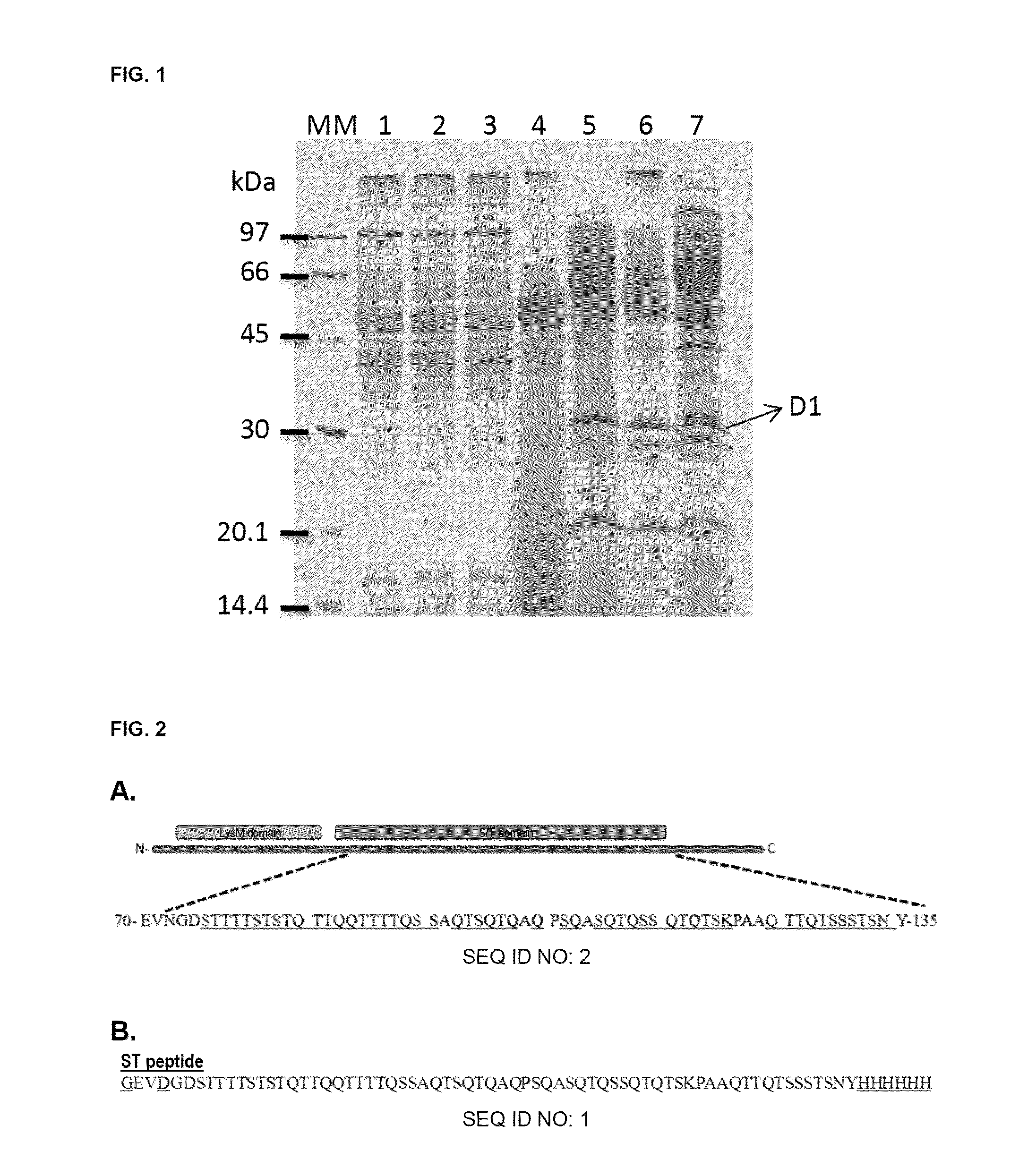Peptide secreted by lactobacillus plantarum with immunomodulating function
a technology of lactobacillus plantarum and peptide, which is applied in the direction of peptide/protein ingredients, immunological disorders, drug compositions, etc., can solve the problems of preventing the establishment of an active immune response against the commensal flora in the gastrointestinal tract, and achieves the effects of promoting secondary migration of effector cells, different functions, and maintaining intestinal homeostasis
- Summary
- Abstract
- Description
- Claims
- Application Information
AI Technical Summary
Benefits of technology
Problems solved by technology
Method used
Image
Examples
example 1
Interaction of the ST Peptide Identified as SEQ ID NO: 1 with Dendritic Cells Derived from Blood
[0080]1.1. Material and Methods
[0081]The dendritic cells were obtained from healthy patients who had neither autoimmune diseases, nor inflammatory diseases nor allergies nor malignant tumors. These subjects had given their written consent for their blood to be used for scientific purposes. The peripheral blood mononuclear cells (PBMCs) were isolated by differential centrifugation in Ficoll-Paque Plus (Amersham Biosciences, Chalfont St. Giles, UK). The cellular fraction LDC (low-density cells) was obtained by overnight centrifugation in NycoPrepe™ solution. The cells present in this LDC fraction were HLA-DR positive in 98-100% of cases, with morphological characteristics typical of the DCs (Ng, et al. (2009). A novel population of human CD56+ human leukocyte antigen D-related (HLA-DR+) colonic lamina propria cells is associated with inflammation in ulcerative colitis. Clin. Exp. Immuno1.15...
example 2
Interaction of the ST Peptide Identified as SEQ ID NO: 1 with Dendritic Cells Obtained from Biopsy of Intestinal Mucosa
[0090]Since the site of action of the ST peptide identified as SEQ ID NO: 1 would in principle be the intestinal mucosa, we decided to try to validate the experiments described in example 1 using DCs isolated from said location.
[0091]2.1. Material and Methods
[0092]Biopsies from the colon were obtained from three healthy patients, who had given their written consent to participate in this study (one woman and two men, age range 30-58 years). These patients had normal intestines, both macroscopically and histologically, and had been examined after reporting changes in intestinal transit or rectal bleeding. Once obtained, the biopsies were collected in complete medium cooled to 4° C. and were processed before the first hour counting from when they were obtained. The biopsies were incubated in Hanks's balanced salt solution (HBSS) (Gibco BRL, Paisley, Scotland, UK) cont...
example 3
Interaction of Dendritic Cells Obtained from Blood Matured with the ST Peptide Identified as SEQ ID NO: 1 with T Lymphocytes
[0096]3.1. Material and Methods
[0097]The T lymphocytes were obtained from peripheral blood mononuclear cells (PBMCs). The PBMCs, obtained from freshly drawn blood as described in example 1, were resuspended in MiniMACs buffer (PBS supplemented with bovine serum albumin 0.5% (w / v) and EDTA 2 mM). This suspension was enriched with T cells by removing the CD14 positive, CD19 positive and HLA-DR positive cells with immuno-magnetized beads (Miltenyi Biotech, Bisley, UK) following the manufacturer's instructions. A percentage of T cells of 94.91%±1.06 (mean±standard deviation) was obtained as the mean value of all the extractions / enrichments.
[0098]The T cells were labeled with 5-carboxyfluorescein diacetate succinimidyl ester (CFSE, Invitrogen Ltd, UK) according to the manufacturer's instructions. The T cells thus labeled (4×105 cells per well) were incubated for 5 d...
PUM
| Property | Measurement | Unit |
|---|---|---|
| Fraction | aaaaa | aaaaa |
| Fraction | aaaaa | aaaaa |
| Fraction | aaaaa | aaaaa |
Abstract
Description
Claims
Application Information
 Login to View More
Login to View More - R&D
- Intellectual Property
- Life Sciences
- Materials
- Tech Scout
- Unparalleled Data Quality
- Higher Quality Content
- 60% Fewer Hallucinations
Browse by: Latest US Patents, China's latest patents, Technical Efficacy Thesaurus, Application Domain, Technology Topic, Popular Technical Reports.
© 2025 PatSnap. All rights reserved.Legal|Privacy policy|Modern Slavery Act Transparency Statement|Sitemap|About US| Contact US: help@patsnap.com



